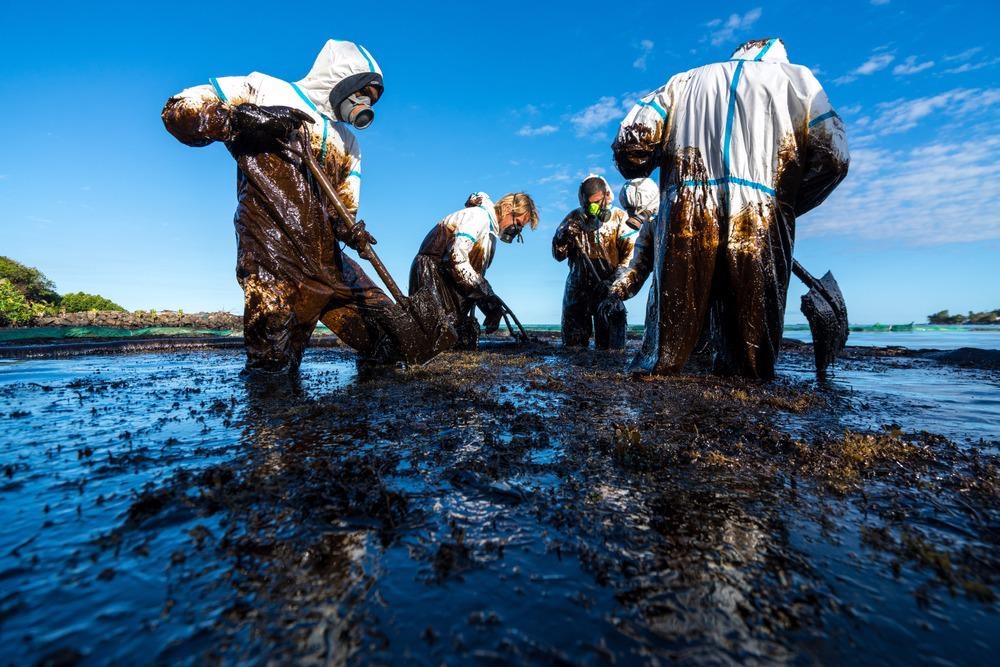A green and adaptive rinsing fluid was created in a new study published in the Journal of Cleaner Production by customizing nanoclay with a nonionic surfactant to rinse stranded oil on beach sand.

Study: Treatment of Oiled Beach Sand Using a Green and Responsive Washing Fluid with Nonionic Surfactant-Modified Nanoclay. Image Credit: ohrim/Shutterstock.com
Upon modification, the abaxial spacing, absorption spikes, thermal decomposition, specific surface area, and element weights changed, indicating that the surfactant has been successfully activated onto the nanoclay.
The impact of washing time, pH, heat, salinity, and the customized nanoclay density on washing achievement was investigated in batch tests.
According to the two-level parametric test, salinity was the most important environmental factor influencing oil removal efficiency. This also showed that the connections of temperature and salinity and salinity and the reconfigured nanoclay concentration were important to the reaction. The detachment tests indicated that adding calcium chloride could significantly reduce turbidity and oil.
Oil Spills Impacts
Ship accidents, machinery corrosion, and mechanical fault during oil extraction, transportation, and storage are all common causes of marine oil spills. Those that cause significant economic losses and have a negative impact on the coastal environment.
The spilled oil may eventually reach the coastline with the wind, current flow, and tides after passing through a series of physical, contaminant, and biological mechanisms. The stranded oil is highly tattered and persistent, necessitating the use of appropriate reaction methods to effectively eliminate the oil from the substances.
Mechanical removal, sediment resettlement, bioremediation, and other response strategies and techniques commonly treat impacted shorelines.
Nanoclays Effectively Reduce Pollution
Because of their natural abundance, nontoxic and inexpensive nature, nanoclays have been used for reducing pollution. But even so, raw nanoclays may be incapable of removing high levels of pollutants; therefore, modifying such nanoclays may improve their contaminant extraction efficiency.
To achieve high oil-dispersion efficiency, halloysite clay nanotubes were loaded with varying configurations of Tween80, Span80, dioctyl sodium sulfosuccinate (DOSS), and modified soybean lecithin.
In correlation, nanoclay modified with nonionic surfactants (including Tween 80) was considered less toxic and more environmentally friendly. The nonionic surfactant can hybridize into clay nanoparticles via H-bonding, dipole interactions, and other procedures, but it does not change the nanoclay's charge properties.
Research Methods Using Nanoclay to Remove Oil Spills
This research aimed to create a green and responsive washing fluid containing nonionic surfactant-modified nanoclay for removing oil from seashores. The modified nanoclay first was categorized using a variety of analytical techniques to investigate modifications in its structural, chemical, and physical properties.
The impacts of the operational variable (washing rate) and environmental factors (temperature, salinity, pH, and nanoclay concentration) on sand cleanup were then investigated in batch surface washing tests. A factorial analysis was performed to investigate the contributions of specific features and two-level interactions to performance overall.
Following the washing of the oiled sand, the nanofluid effluents were treated with calcium chloride to remove the oiled nanoclay from water. In addition, the thermodynamic miscibility model was used to determine how concentration and temperature affected oil/water miscibility in the existence of the modified nanoclay.
Oil Clean Up with Nanoclay
To determine whether the surfactant had already been loaded on to nanoclay, the TGA test was performed on both fresh and modified nanoclay. The TGA characteristics of pristine nanoclay revealed an 8.44 percent mass loss between 30 and 160 °C, which was due to moisture removal as from surface and crystal lattice. SEM measurements were also taken to examine the surface characteristics of the pristine and modified nanoclay.
Their surfaces varied greatly and had shown irregular constructions with differently sized distributions.
Even without surfactant modification, the nanoclay had a more tremendous and aggregated morphology as well as a larger surface area. In comparison, the modified nanoclay exhibited less agglomeration but smoother surfaces and numerous tiny flakes with heavily crumpled structures. Researchers indicate the potential of this method to reduce oil spills on the seashore.
Future Impacts
The discharge of the traditional surface washing agent further into the environment may have an impact on the coastal biota. The deadly and sublethal consequences of large commercial products containing and not containing crude oil on grass shrimp larvae and adults Following the treatment of an oiled material, mussels, sea urchins, and mysids have been found to be extremely sensitive to CytoSol, a commercial surface washing agent. Meanwhile, it is expected that nanoclays is effluent from surface washing will be easily treated and will not cause any harm.
Further Research
Ultimately, the nonionic surfactant-modified nanoclay has a lot of potential for oil cleanup, and it could be an excellent alternative to the existing washing agents. However, more research is needed to investigate its effectiveness.
Continue reading: Replenishing Water Sources with Electrospun Nanofiber Membranes.
Reference
Bi, H., et al. (2021). Treatment of oiled beach sand using a green and responsive washing fluid with nonionicsurfactant-modified nanoclay. Journal of Cleaner Production. Available online 20 December 2021. https://www.sciencedirect.com/science/article/pii/S0959652621042888?via%3Dihub
Disclaimer: The views expressed here are those of the author expressed in their private capacity and do not necessarily represent the views of AZoM.com Limited T/A AZoNetwork the owner and operator of this website. This disclaimer forms part of the Terms and conditions of use of this website.